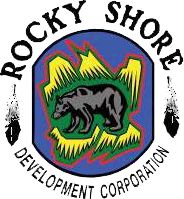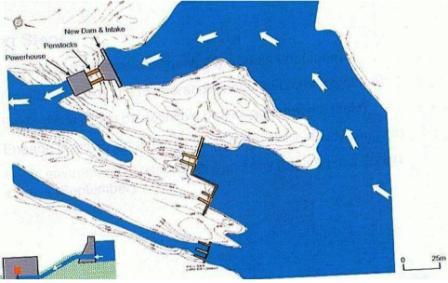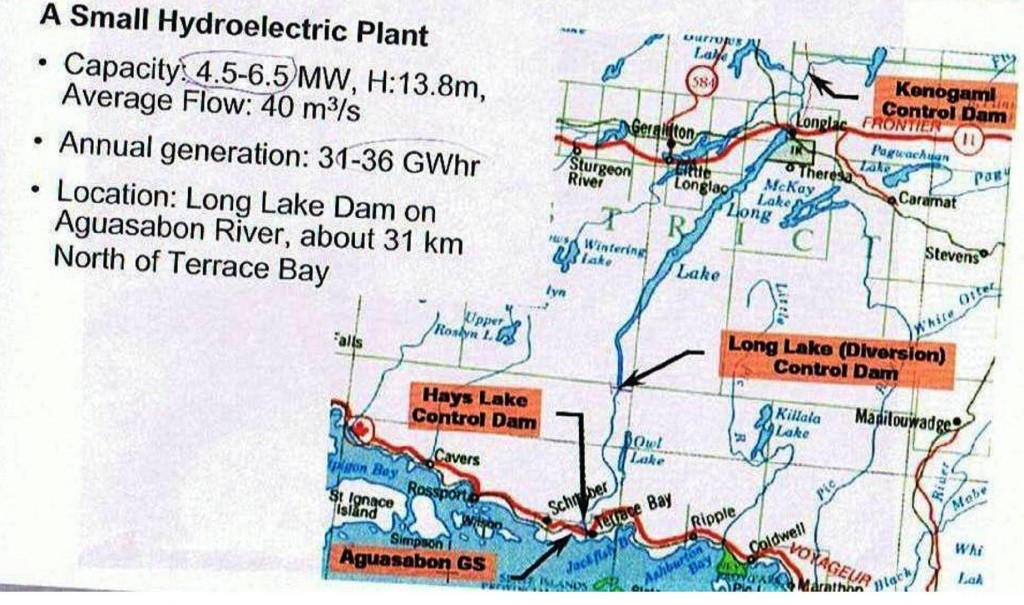
Ginoogaming First NationEconomic Development
 In 2003, Ginoogaming First Nation applied to the federal government and obtained authority to establish Rocky Shore Development Corporation operating for the First Nation band, Ginoogaming. During this time, concentration was placed on the bingo operation and some minor programs. After year 2005, the Corporation remained dormant until year 2008. After the general band election of 2007 and with a new leadership, Chief Celia Echum applied for funding from sources and restarted RSDC during March 2008. RSDC is concentrating on local community projects, some with guidance required and some with actual hands-on development.
In 2003, Ginoogaming First Nation applied to the federal government and obtained authority to establish Rocky Shore Development Corporation operating for the First Nation band, Ginoogaming. During this time, concentration was placed on the bingo operation and some minor programs. After year 2005, the Corporation remained dormant until year 2008. After the general band election of 2007 and with a new leadership, Chief Celia Echum applied for funding from sources and restarted RSDC during March 2008. RSDC is concentrating on local community projects, some with guidance required and some with actual hands-on development.
Longlac Lumber Inc.
At the present time everyone is aware that due to the economy our sawmill employees have had to endure a very fragile work environment. Never knowing when there will be more layoffs. This coming week the sawmill will have only 6 workers providing only clean up and maintenance to the sawmill. The Planer also operates on a weekly schedule which changes from time to time. All employees have been doing their best to accommodate the demands of the mill management, some working 2 or 3 positions simultaneously in order to keep the mill operating and themselves working.
Mill employees almost unanimously voted “Not in Favour” of the Contract that was offered to them. This Contract was to cover a 5 yr term, for various reasons the mill employees determined that the offer was not in their best interests. To date no other offer or changes have been made to the original offer. On October 16th another LLEA meeting was held, this time the only item on the Agenda being whether or not to accept or reject a particular request that LLFP Management was making of the employees.
The Buchanen Partners were asking the LLFP employees to vote in favour of all employees waiting until August 2009 before anyone could request their termination or severance pay. For every employee this meant something different, some are not even entitled to any of this since you must be employed for at least 3 yrs before you qualify for it. For others who are collecting EI, any monies they receive as a result of a layoff are subject to deductions to Revenue Canada for the amount of EI you collect. Once you receive your severance and termination you also have no “recall rights”, LLFP never has to employ you again. The Buchanen Partners assured the Employees that by agreeing to this request they put their Mill at an advantage over other Sawmills in terms of which sawmill to re-open when the economy permits the full time operation of a Mill.Employees voted in favour of “NOT” requesting their termination or severance pay until August 2009, at which time the Management is hopeful the sawmill can at least be back to 2 FT shifts.
Making Ground River Road and Bridge
The Making Ground River Crossing is a bridge and roadway replacement project. This project is designed to reduce congestion and improve safety issues. The bridge is in such advanced state of deterioation that a complete replacement is required. The replacement is to consist of a new two-lane bridge complete with a pedestrain sidewalk. In addition to addressing the bridge, the roadway will need to be raised and constructed on the north and south approaches due to the Navigable Waters Bridges Regulation. Due to extreme weather conditions roadway users struggle to get to and from the community and at times becomes impossible to maneuver. The safety and health of Ginoogaming First Nation band members are at risk as well as other road users from the industrial, commercial and private sectors. Finally after 12 years of searching for funds, GFN and RSDC have identified working partners MNR, INAC, MNDM, and BFPL to help get this project started. Representatives from each group have held numerous meetings to date to discuss its position and will work together. Genevieve Knauff, Guylene Levesque and RSDC staffing have gone ahead with its proposals to the First Nation Infrastructure Fund and Northern Ontario Heritage Fund. With good fortune the replacement project will be awarded funding after years of research, feasibility studies, commitments Ginoogaming will soon be utilizing a new two lane bridge.
A project of this nature will require time; we can expect a timeframe of a year and 6 months which would provide the community with a resilient Making Ground River Bridge and Roadway most importantly employment for the duration of the project for our GFN members. Based on funding approvals and receipt, it is expected the project could start as early as spring 2010.

AWDMP Program
Aboriginal Workforce Development and Maintenance Program (AWDMP)
Ginoogaming First Nation established a workforce development and maintenance model known as the AWDMP during year 1996 when the Longlac sawmill was expected to add a second line of production and hire additional 120 persons. This bump up in workforce and production was reviewed and we recognized that some workers at the mill site already were experience work related problems. Funding was secured at that time to establish a training centre and with continued funding from various sources, the program flourished and became well known across the northern territory. The Longlac sawmill operation benefited from the better work site improvements involving staffing, production and a host of other items offered by the AWDMP program. Downsizing of the sawmill operation began two years past due to the declining demand for lumber in USA and the high Loonie. The USA problems exist today and the Longlac sawmill has decreased to a staff of 20. But it is expected to return to full force in time and require the additional people to fulfill the needs of the production. The AWDMP model is being updated and rewritten by a Curriculum Developer and will be ready for use by year end. It is our plan to restart the AWDMP training in year 2009 at Ginoogaming and offer the model for lease to some outside agencies. There are many people in our community that would benefit from the Aboriginal Workforce Development Maintenance Program.
A recap of the model itself and its developments are summarized below:
- In 1996 the AWDMP was developed in Ginoogaming
- To date, invested $500,000 mainly on operations
- Trained Aboriginal/non Aboriginal/Metis peoples
- Being updated by Curriculum Developer
- Required at Attawapiskat Training
- Required at Ginoogaming First Nation Training
- Required at Electric Project Training
- Lease $10,000 – $12,500 per year
- Copyrighted 6 modules
As a current update, on August 25, 2008 an email from received from Sally Braun, Community Learning Networks Project Coordinator, Chair: Attawapiskat Training and Employment Committee Attawapiskat First Nation Education Authority Training which read, in part, as follows: “There are many people in the community that would benefit from this (AWDMP). This is why, we are suggesting we might need to use the curriculum 4 – 5 times a year over a 2 year period. Most of our venues can accommodate up to 20 people comfortably. I don’t know if we’d want the class to be larger. So that adds up to 180 – 200 people from Attawapiskat going through the program in 2 years. One thing you could consider adding to the curriculum if it is not already there, is aptitude testing. Some people do not know where their skill set lies and this kind of testing will direct them onto the right party. We would also want to send someone to you for you to train as an instructor.”
Kenogami Forest Planning
In the 1994 Crown Forest Sustainability Act (CFSA) states; the province has a duty to consult with the public and First Nations about forest operations on crown land. During this process First Nations have several opportunities to voice their concerns. Forest Management Planning (FMP) are 10 year planning cycles that is very important for First Nations to comment on forest operations that will affect the lakes, rivers and forests that we use.

It is important to know:
Who is involved – MNR, BFPL, LWI, Hunting and Fishing Resorts and First Nations Communities
What is important – our Values maps (wildlife, traditional fishing and hunting grounds, sensitive areas of interest, etc.), what forest benefits the plan should strive to provide
Where – the Kenogami Forest where harvesting, planting and tendering will take place, where access roads be constructed
When – attending meetings once a month and have attended 4 meetings on behalf of Ginoogaming First Nation, it’s a 10 year of FMP and a 2 year commitment
Why – it’s very important to take this opportunity to have a voice at these tables and to discuss what is happening around us.
Long Lake Dam Hydro-Electric
The project started during year 2006 and required the participation of two First Nations, Ginoogaming and Long Lake No. 58. Preliminary work was started on looking at the viability of the project and the funding requirements. Later, the project was temporarily halted but work on the development continued with Ontario Power Generation (OPG) who is working for the Ontario Power Authority (OPA). The development work continued to the point of securing initial funding from Indian and Northern Affairs Canada and progressing further into the project development. On October 7, 2008 starting at 9:00 a.m. at the Fort William First Nation Cultural Centre, a meeting was held between Indian and Northern Affairs Canada, Ginoogaming First Nation, Long Lake No. 58 First Nation and Aboriginal Business Network on the Long Lake Dam Hydro-Development Project. The Thunder Bay meeting was set up by Doris Odjick, Indian and Northern Affairs to restart the Long Lake Dam Hydro-Development Project that was stalled for funding. INAC will release $1 million funds to restart the project for 3 years which could be separated as $200K year 2008/09, $600K year 009/10, and $200K year 2010/11. These dollars are needed towards the project. The cost of the project is $51.2 million with equity required from participating First Nations. 25% of the equity in year 2010 dollars is $12.8 million. Therefore, Ginoogaming and Long Lake 58 will be responsible for the $12.8 million.
Feasibility study was done by Ontario Power Generation on their own. A copy will be required by INAC. There is 70% debt financing by OPG and 30% debt financing in the form of equity by First Nations which represents about $4 million. It was determined that First Nations are exempt from PST and GST in the project as a ruling was made to exempt the GST for off-reserve First Nations. OPG is committed on going forward on the project. A MOU is not necessary by the First Nations as they are already covered by past settlement agreements. Two First Nations are to join development general partnership to buy all material FOB Pays Platt and ship to next job site 30 kilometres from dam site. Is Government agreeable that we are exempt? Make sure CRA and Minister of Finance is on board. 60% of the project is material. KPMG did the Manitoba project and the government lost their case on the tax exemption so a ruling is already made. Creation of a general partnership would have to be made. Met with elders during March 2008. The cost of hydro would be $87.50 per megawatt hour. Ontario Power Authority (OPA) would be selling power to Ontario Power Generation (OPG).

Terms of reference has not been done yet. By December 2009 OPG will have completed the design stage at $1.2 million cost. By December 2009 First Nations to have 12.8% funding ready. new Band Council Resolutions required soon as possible. Financial commitment from both is needed.
In general, the project will be producing 7.4 megawatts power about year 2011/12 operating at 60 – 61% efficiency. The low rating is because the dam does not operate during winter months due to free up. Nevertheless, the project has a cost figure and tabled accordingly to achieve the results. Each First Nation will receive 12.5%, meaning 25% to both First Nations. dollars will be calculated so that the First Nations equity is being paid off over an extended period of years, but the First Nations will be receiving a n adjusted cash flow contribution after the dam starts operating during years 2010/11. In time, after a number of years, the equity will be paid off and each First Nation will receive the full 12.5% dollar contribution. INAC mentioned that it is a favourable project for the First Nations of Ginoogaming and Long Lake No. 58. It was stated that additional power dams may be constructed on the Long Lake section north of this project but will depend upon the success of this particular project. The replication would be easy using the Long Lake Dam Project as a template. OPA will be constantly searching for power as the years progressed. As further note, there are two other First Nations being involved on a similar project, that is Pays Platt and Pic River First Nations, on the Brookfield project on Hayes Lake producing more power that the Long Lake dam. The Hayes Lake initiative or known as the Brookfield project will produce 10 to 12 megawatts in comparison with our Long Lake 7.4 megawatts.
The purpose of the meeting was to enlighten everyone that INAC dollars will flow after INAC receives necessary documentation from Wayne Greer to satisfy Ottawa of the developments. We have to produce new Band Council Resolutions. In time, a total of four First Nations will be benefitting from the two separate initiatives which the government totally supports for First Nations revenues.
